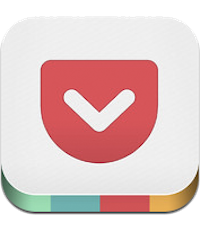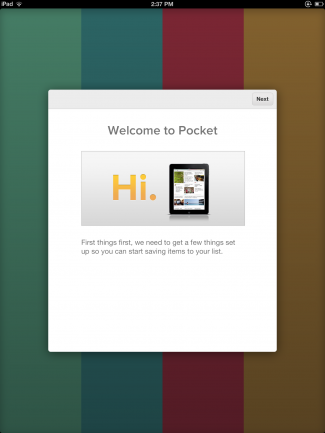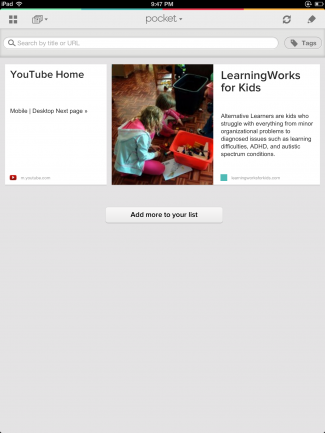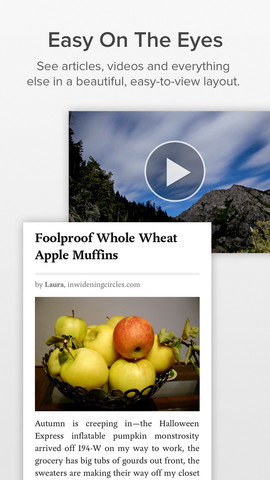DailyBean
LQ: 9.6
Recommended Age: 4+
Skills Used: Self-Awareness, Self-Control, Reading, Writing

Pocket is an application available across a large variety of platforms that allows users to store, sort, and share digital content from the web. Similar to many personal bookmarking apps and websites, Pocket allows users to save their favorite webpages, images, videos, and other content to be viewed later or shared with friends and family via social networking sites. This app also allows users to organize their saved content using tags, allowing for ease of access. Pocket is great for busy users who find they have more content to browse than time. Archiving webpages and other media in this app is a great way to keep track of huge amounts of content. Users will find this app’s clean and simple design easy to use and navigate. There are additional customization options for reading webpages, as well as web browser add-ons for easy archiving on a home computer. This app contains no inappropriate content, but parents should exercise supervision whenever their child is browsing the open web. This app is recommended to any user ages 6 and up.
Arranging and coordinating materials in order to complete a task.
 Users will find Pocket's organizational features extremely helpful when trying to keep track of a constantly expanding library of digital media. Whether bookmarking an interesting blog article for later reading, storing a favorite or funny picture to share with friends, or watching an informative video, users can save, tag, and sort their digital life for ease of access in the near or distant future. Pocket is an advanced way to bookmark digital content. The app even allows users to access content when disconnected from the internet. Users may Pocket on an assortment of platforms including mobile and browser based, making staying organized on the web simple and easy.
Users will find Pocket's organizational features extremely helpful when trying to keep track of a constantly expanding library of digital media. Whether bookmarking an interesting blog article for later reading, storing a favorite or funny picture to share with friends, or watching an informative video, users can save, tag, and sort their digital life for ease of access in the near or distant future. Pocket is an advanced way to bookmark digital content. The app even allows users to access content when disconnected from the internet. Users may Pocket on an assortment of platforms including mobile and browser based, making staying organized on the web simple and easy.
Developing a systematic approach for setting and achieving goals.
Users will exercise their Planning thinking skill while using Pocket to archive favorite webpages, videos, and photographs for later viewing. Whether storing sources for an upcoming class project or assignment or keeping track of an interesting blog article to read during free time, users will greatly benefit from Pocket's ability to support planning through the app's features and customization options. For example, when searching for sources and information for an upcoming school project, users may find it easier to simply compile sources in Pocket to save, sort, tag, and read during later phases of the project. Using the app to keep information archived is an excellent way to support and exercise the Planning thinking skill.
Understanding our own actions, thoughts and feelings.
Using Pocket to keep track of personally interesting content from the web is an excellent way to exercise the Self-Awareness thinking skill. Users can sort and store an interesting website, funny photograph, or entertaining video for later use or sharing with friends. Users can tag and sort their saved media, making it simple an easy to organize. Pocket is an excellent way to expand an existing interest area or discover something new. Saving media for later reading and exploring lets users read or browse at their own pace during free time. Pocket can help users expand their knowledge in a subject area by making it easy to save and catalogue large amounts of media in numerous formats.
Using Pocket to keep your digital life organized and accessible is a great way to practice the Organization, Planning, and Self-Awareness thinking skills. Try some of our suggested activities or leave a comment at the bottom of the page to share how you made this app work for you.
 Browse some of your child's favorite webpages or search youtube for interesting videos. When discovering something interesting that your child might like to revisit later or share with a friend, save the link to Pocket. After the webpage, music, photo, or other media has been imported to Pocket, be sure your child uses "tags" to make sort the content and make it easy to locate in the future. Pocket will automatically sort content by media type, but your child can also sort the content by topic or other keywords to personalize the media library.
Browse some of your child's favorite webpages or search youtube for interesting videos. When discovering something interesting that your child might like to revisit later or share with a friend, save the link to Pocket. After the webpage, music, photo, or other media has been imported to Pocket, be sure your child uses "tags" to make sort the content and make it easy to locate in the future. Pocket will automatically sort content by media type, but your child can also sort the content by topic or other keywords to personalize the media library.
Talk with your child about the ideal times to browse his or her saved content from the web. Your child can set aside time for exploring and learning on the web after homework is finished or before bed. While browsing the web or searching for news, your child may come across content and articles of interest. Encourage your child to prioritize and concentrate effort where it is most important. For example, while searching for information or sources for a school project your child may come across an unrelated video or article. Using Pocket to save this interesting content and using the planning to return to it when appropriate is an excellent way to exercise the Planning thinking skill.
Assist your child in compiling a catalogue of interesting and fun media in Pocket. Your child can spend time archiving interesting articles on Wikipedia or browsing for videos of a favorite music artist on Youtube. You're child should make an effort to populate Pocket with content that is personally interesting or useful. For example, if your child has a great interest in hockey, he or she can spend time populating the app with interesting articles, videos, and even pictures. To keep the media organized your child may want to employ the "tag" feature which allows the inclusion of keywords with archived content. This feature can help your child keep track of related content and maintain a well organized log of expanding interest areas.
 For some children with ADHD staying on task and keeping materials organized can both be a challenge. Success in school often relies on practicing and developing these skills inside and outside of the classroom. Pocket can be an excellent tool for both helping children with ADHD practice and develop organizational and planning skills. For children who have difficulty staying on task due to distractions in their immediate environment, Pocket provides a great resource for archiving media for later use. Children who have trouble staying organized during research and school projects may also benefit from the features which Pocket provides.
For some children with ADHD staying on task and keeping materials organized can both be a challenge. Success in school often relies on practicing and developing these skills inside and outside of the classroom. Pocket can be an excellent tool for both helping children with ADHD practice and develop organizational and planning skills. For children who have difficulty staying on task due to distractions in their immediate environment, Pocket provides a great resource for archiving media for later use. Children who have trouble staying organized during research and school projects may also benefit from the features which Pocket provides.
How to Use Pocket for Children with ADHD:
 For children with dyslexia who struggle with reading and writing skills, additional practice outside of the classroom can be of great benefit. These children may have difficulty recalling the definitions of different words, identifying and decoding individual letters, or synthesizing and extrapolating information from their reading. Utilizing apps like Pocket to help archive practice materials for reading outside the classroom can give children a safe and unthreatening venue in which to practice and enhance reading proficiency.
For children with dyslexia who struggle with reading and writing skills, additional practice outside of the classroom can be of great benefit. These children may have difficulty recalling the definitions of different words, identifying and decoding individual letters, or synthesizing and extrapolating information from their reading. Utilizing apps like Pocket to help archive practice materials for reading outside the classroom can give children a safe and unthreatening venue in which to practice and enhance reading proficiency.
How to Use Pocket for Children with dyslexia:
Pocket is just one of many places to store important or personally interesting information from the web. Try some of our other suggested apps below and let us know which one you prefer in the comment section at the bottom of the page.
Delicious is another bookmarking website and app for helping users save and share their favorite websites and media. This service also allows users to archive and tag content from across the web for ease of access in the future. Learn more in our Delicious review.
![]()
Evernote
Evernote allows users to save media and content across a large array of formats, as well as personal voice and text based notes. This app is an excellent way to organize, save, and share a constantly expanding digital footprint. Learn more in our Evernote review.